NCERT Solutions for Exercise 8.1 Class 10 Maths Chapter 8 - Introduction to Trigonometry
CBSE Class 10th Exam Date:01 Jan' 26 - 14 Feb' 26
The exercise establishes basic trigonometric foundations by teaching about the six vital ratios, which include sine, cosine, tangent, cosecant, secant and cotangent. The ratios help us to understand angle-per-length relationships through right-angled triangles. We have to master the exercise because it creates essential foundations for higher-level trigonometric subjects and serves as a key part of the Class 10 mathematics syllabus.
This Story also Contains
- NCERT Solutions Class 10 Maths Chapter 8: Exercise 8.1
- Access Solution of Introduction to Trigonometry Class 10 Chapter 8 Exercise: 8.1
- Topics covered in Chapter 8, Introduction to Trigonometry: Exercise 8.1
- NCERT Solutions of Class 10 Subject Wise
- NCERT Exemplar Solutions of Class 10 Subject Wise

The NCERT Solutions for Class 10 Maths present practical methods for using trigonometric ratios according to the content found in NCERT textbooks. The exercises guide students to evaluate trigonometric ratios when given dimensional triangle measurements and help students determine missing lengths through ratio analysis while confirming trigonometric identity relations. Exercise 8.1 in the NCERT Books helps students strengthen their trigonometry knowledge as it develops their ability to solve complex mathematical problems required for higher educational levels.
NCERT Solutions Class 10 Maths Chapter 8: Exercise 8.1
Access Solution of Introduction to Trigonometry Class 10 Chapter 8 Exercise: 8.1
Q1 In $\Delta \: ABC$ , right-angled at $B, AB = 24 \: cm$ , $BC = 7 \: cm$ . Determine : $(i)\; \sin A, \cos A$ $(ii)\; \sin C, \cos C$
Answer:
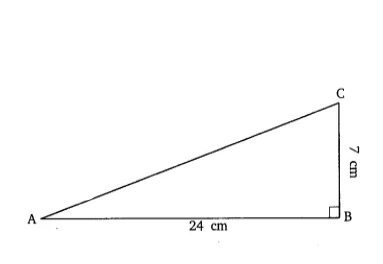
We have,
In $\Delta \: ABC$ , $\angle$ B = 90, and the length of the base (AB) = 24 cm and length of perpendicular (BC) = 7 cm
So, by using Pythagoras theorem,
$\\AC^2 = AB^2 + BC^2\\ AC = \sqrt{AB^2+BC^2}$
Therefore, $AC = \sqrt{576+49}$
$AC = \sqrt{625}$
AC = 25 cm
Now,
(i) $\sin A = P/H = BC/AB = 7/25$
$\cos A = B/H = BA/AC = 24/25$
(ii) For angle C, AB is perpendicular to the base (BC). Here B indicates to Base and P means perpendicular wrt angle $\angle$ C
So, $\sin C = P/H = BA/AC = 24/25$
and $\cos C = B/H = BC/AC = 7/25$
Q2 In Fig. 8.13, find $\tan P - \cot R$ .
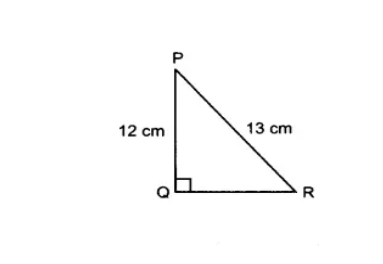
Answer:
We have, $\Delta$ PQR is a right-angled triangle, length of PQ and PR are 12 cm and 13 cm respectively.
So, by using Pythagoras theorem,
$QR = \sqrt{13^2-12^2}$
$QR = \sqrt{169-144}$
$QR = \sqrt{25} = 5\ cm$
Now, According to question,
$\tan P -\cot R$ = $\frac{RQ}{QP}-\frac{QR}{PQ}$
= 5/12 - 5/12 = 0
Q3 If $\sin A=\frac{3}{4},$ calculate $\cos A$ and $\tan A$ .
Answer:
Suppose $\Delta$ ABC is a right-angled triangle in which $\angle B = 90^0$ and we have $\sin A=\frac{3}{4},$
So,
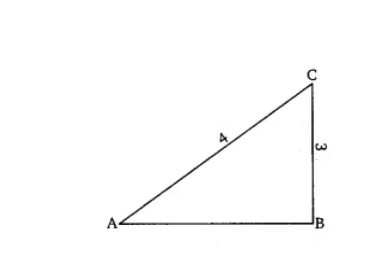
Let the length of AB be 4 unit and the length of BC = 3 unit So, by using Pythagoras theorem,
$AB = \sqrt{16-9} = \sqrt{7}$ units
Therefore,
$\cos A = \frac{AB}{AC} = \frac{\sqrt{7}}{4}$ and $\tan A = \frac{BC}{AB} = \frac{3}{\sqrt{7}}$
Q4 Given $15 \: \cot A=8,$ find $\sin A$ and $\sec A$ .
Answer:
We have,
$15 \: \cot A=8,$ $\Rightarrow \cot A =8/15$
It implies that In the triangle ABC in which $\angle B =90^0$ . The length of AB be 8 units and the length of BC = 15 units
Now, by using Pythagoras theorem,
$AC = \sqrt{64 +225} = \sqrt{289}$
$\Rightarrow AC =17$ units
So, $\sin A = \frac{BC}{AC} = \frac{15}{17}$
and $\sec A = \frac{AC}{AB} = \frac{17}{8}$
Q5 Given $\sec \theta =\frac{13}{12},$ calculate all other trigonometric ratios.
Answer:
We have,
$\sec \theta =\frac{13}{12},$
It means the Hypotenuse of the triangle is 13 units and the base is 12 units.
Let ABC is a right-angled triangle in which $\angle$ B is 90 and AB is the base, BC is perpendicular height and AC is the hypotenuse.
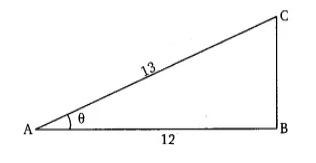
By using Pythagoras theorem,
$BC = \sqrt{169-144}=\sqrt{25}$
BC = 5 unit
Therefore,
$\sin \theta = \frac{BC}{AC}=\frac{5}{13}$
$\cos \theta = \frac{BA}{AC}=\frac{12}{13}$
$\tan \theta = \frac{BC}{AB}=\frac{5}{12}$
$\cot \theta = \frac{BA}{BC}=\frac{12}{5}$
$\sec \theta = \frac{AC}{AB}=\frac{13}{12}$
$\csc \theta = \frac{AC}{BC}=\frac{13}{5}$
Answer:
We have, A and B are two acute angles of triangle ABC and $\cos A =\cos B$
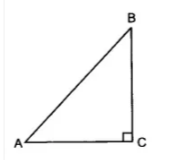
According to question, In triangle ABC,
$\cos A =\cos B$
$\frac{AC}{AB}=\frac{BC}{AB}$
$\Rightarrow AC = AB$
Therefore, $\angle$ A = $\angle$ B [angle opposite to equal sides are equal]
Q7 If $\cot \theta =\frac{7}{8},$ evaluate: $(i)\; \frac{(1+\sin \theta)(1-\sin \theta)}{(1+\cos \theta)(1-\cos \theta)}$ $(ii)\; \cot ^{2}\theta$
Answer:
Given that,
$\cot \theta =\frac{7}{8}$
$\therefore$ perpendicular (AB) = 8 units and Base (AB) = 7 units
Draw a right-angled triangle ABC in which $\angle B =90^0$
Now, By using Pythagoras theorem,
$AC^2 = AB^2+BC^2$
$AC = \sqrt{64 +49} =\sqrt{113}$
So, $\sin \theta = \frac{BC}{AC} = \frac{8}{\sqrt{113}}$
and $\cos \theta = \frac{AB}{AC} = \frac{7}{\sqrt{113}}$
$\Rightarrow \cot \theta =\frac{\cos \theta}{\sin \theta} = \frac{7}{8}$
$(i)\; \frac{(1+\sin \theta)(1-\sin \theta)}{(1+\cos \theta)(1-\cos \theta)}$
$\Rightarrow \frac{(1-\sin^2\theta)}{(1-\cos^2\theta)} = \frac{\cos^2\theta}{\sin^2\theta} = \cot ^2\theta$
$=(\frac{7}{8})^2 = \frac{49}{64}$
$(ii)\; \cot ^{2}\theta$
$=(\frac{7}{8})^2 = \frac{49}{64}$
Q8 If $3\cot A=4,$ check wether $\frac{1-\tan ^{2}A}{1+\tan ^{2}A}=\cos ^{2}A-\sin ^{2}A$ or not.
Answer:
Given that,
$3\cot A=4,$
$\Rightarrow \cot = \frac{4}{3} = \frac{base}{perp.}$
ABC is a right-angled triangle in which $\angle B =90^0$ and the length of the base AB is 4 units and length of perpendicular is 3 units
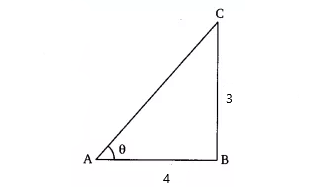
By using Pythagoras theorem, In triangle ABC,
$\\AC^2=AB^2+BC^2\\ AC = \sqrt{16+9}\\ AC = \sqrt{25}$
AC = 5 units
So,
$\tan A = \frac{BC}{AB} = \frac{3}{4}$
$\cos A = \frac{AB}{AC} = \frac{4}{5}$
$\sin A = \frac{BC}{AC} = \frac{3}{5}$
$\frac{1-\tan ^{2}A}{1+\tan ^{2}A}=\cos ^{2}A-\sin ^{2}A$
Put the values of above trigonometric ratios, we get;
$\Rightarrow \frac{1-9/4}{1+9/4} = \frac{16}{25}-\frac{9}{25}$
$\Rightarrow -\frac{5}{13} \neq \frac{7}{25}$
LHS $\neq$ RHS
Q9 In triangle $ABC$ , right-angled at $B$ , if $\tan A =\frac{1}{\sqrt{3}},$ find the value of:
$(i) \sin A\: \cos C + \cos A\: \sin C$
$(ii) \cos A\: \cos C + \sin A\: \sin C$
Answer:
Given a triangle ABC, right-angled at B and $\tan A =\frac{1}{\sqrt{3}}$ $\Rightarrow A=30^0$
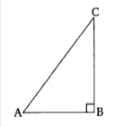
According to question, $\tan A =\frac{1}{\sqrt{3}} = \frac{BC}{AB}$
By using Pythagoras theorem,
$\\AC^2 = AB^2+BC^2\\ AC = \sqrt{1+3} =\sqrt{4}$
AC = 2
Now,
$\\\sin A = \frac{BC}{AC} = \frac{1}{2}\\ \sin C =\frac{AB}{AC} = \frac{\sqrt{3}}{2}\\ \cos A = \frac{AB}{AC} = \frac{\sqrt{3}}{2}\\ \cos C = \frac{BC}{AC} = \frac{1}{2}$
Therefore,
$(i) \sin A\: \cos C + \cos A\: \sin C$
$\\\Rightarrow \frac{1}{2}\times\frac{1}{2}+\frac{\sqrt{3}}{2}\times \frac{\sqrt{3}}{2}\\ \Rightarrow1/4 +3/4\\ \Rightarrow4/4 = 1$
$(ii) \cos A\: \cos C + \sin A\: \sin C$
$\\\Rightarrow \frac{\sqrt{3}}{2}\times \frac{1}{2}+\frac{1}{2}\times\frac{\sqrt{3}}{2}\\ \Rightarrow \frac{\sqrt{3}}{4}+\frac{\sqrt{3}}{4}\\ \Rightarrow \frac{\sqrt{3}}{2}$
Answer:

We have, PR + QR = 25 cm.............(i)
PQ = 5 cm
and $\angle Q =90^0$
According to question,
In triangle $\Delta$ PQR,
By using Pythagoras theorem,
$\\PR^2 = PQ^2+QR^2\\ PQ^2 =PR^2-QR^2 \\ 5^2= (PR-QR)(PR+QR)\\ 25 = 25(PR-QR) \\$
PR - QR = 1........(ii)
From equation(i) and equation(ii), we get;
PR = 13 cm and QR = 12 cm.
therefore,
$\\\sin P= \frac{QR}{PR}= 12/13\\ \cos P = \frac{PQ}{RP} = 5/13\\ \therefore \tan P = \frac{\sin P}{\cos P} = 12/5$
Q11 State whether the following are true or false. Justify your answer.
(i) The value of $\tan A$ is always less than 1.
(ii) $\sec A=\frac{12}{5}$ for some value of angle A.
(iii) $\cos A$ is the abbreviation used for the cosecant of angle A.
(iv) $\cot A$ is the product of cot and A.
(v) $\sin \Theta =\frac{4}{3}$ for some angle $\Theta .$
Answer:
(i) False,
because $\tan 60 = \sqrt{3}$ , which is greater than 1
(ii) True,
because $\sec A \geq 1$
(iii) False,
Because $\cos A$ abbreviation is used for cosine A.
(iv) False,
because the term $\cot A$ is a single term, not a product.
(v) False,
because $\sin \theta$ lies between (-1 to +1) [ $-1\leq \sin \theta\leq 1$ ]
Topics covered in Chapter 8, Introduction to Trigonometry: Exercise 8.1
1. Calculating Trigonometric Ratios: Individuals can determine the values of trigonometric ratios when given the lengths of right-angled triangles.
2. Determining Side Lengths: Calculating the unknown side lengths of right-angled triangles becomes possible when applying known trigonometric ratios.
3. Verifying Trigonometric Identities: By using both calculation and reasoning, students verify fundamental trigonometric identities.
4. Real-Life Applications: Applying trigonometric principles helps solve real-life situations where trigonometry measures sides and angles in practical problems.
5. Definition of Trigonometric Ratios: Understanding sine, cosine, tangent, cosecant, secant, and cotangent in the context of right-angled triangles.
Trigonometric Ratios | Formula |
sin θ | $\frac{\text{Perpendicular}}{\text{Hypotenuse}}$ |
cos θ | $\frac{\text{Base}}{\text{Hypotenuse}}$ |
tan θ | $\frac{\text{Perpendicular}}{\text{Base}}$ |
cosec θ | $\frac{\text{Hypotenuse}}{\text{Perpendicular}}$ |
sec θ | $\frac{\text{Hypotenuse}}{\text{Base}}$ |
cot θ | $\frac{\text{Base}}{\text{Perpendicular}}$ |
Also, see-
NCERT Solutions of Class 10 Subject Wise
Students must check the NCERT solutions for class 10 of Mathematics and Science Subjects.
NCERT Exemplar Solutions of Class 10 Subject Wise
Students must check the NCERT Exemplar solutions for class 10 of Mathematics and Science Subjects.
Frequently Asked Questions (FAQs)
Cos means Cosine is the ratio of Adjacent Side and Hypotenuse
tan θ=sin θ/cos θ
The multiplicative inverse of sine is known as the cosecant
The six trigonometric ratios are
Sine
Cosine
Tangent
Cotangent
Cosecant
Secant.
NCERT solutions for Class 10 Maths chapter 8 exercise 8. 1 consists of 11 Questions in which 7 are short answers, 3 of them are long answers and the remaining one is a short answer with reasoning and all the questions are based on trigonometric ratios.
The three basic trigonometric ratios are sine, cosine and tangent.
The ratio of the opposite side to the hypotenuse of the right angle triangle is known as the sine.
Sin θ=opposite side/hypotenuse
Questions related to CBSE Class 10th
On Question asked by student community
The CBSE Sahodaya Question Papers for Class 10 (2025-26) are not released centrally by the board as a single PDF.
Here is the essential information you need:
-
Local Release: The papers are designed and released by the individual Sahodaya School Clusters (groups of CBSE schools) just before or during the pre-board exam dates (typically held in December and January). Therefore, you must check your local cluster's portal or directly with your school administration.
-
Best Practice: The official model papers, based on the full 2026 syllabus, are the most reliable tool for practice. These accurately reflect the structure, format, and competency-based questions used in the Sahodaya exams.
You can download the latest CBSE Class 10 Model Papers to simulate the Sahodaya tests here: https://school.careers360.com/articles/sahodaya-question-paper-2025 . Focus on that pattern
Hi! If you’re looking for the Class 11 English half yearly question paper for 2025-26 (CBSE board), you’ll find the right resource once you check the link provided from Careers360. Solving previous or sample papers is a smart way to prepare, as it helps you understand the question types, marking scheme, and important topics. This practice will boost your confidence and help you manage your time well in the actual exam.
https://school.careers360.com/boards/cbse/cbse-class-11-half-yearly-sample-papers-2025-26
Hi dear candidate,
Could you please specify us the board of education for which you need the half yearly question papers of class X so that we can help you further.
Below are few links which may help you and it has all the subjects with English as well:
CBSE Class 10 Half Yearly Exam Question Paper 2025-26 with Answer Key & Analysis
ICSE Class 10 Half Yearly Sample Papers 2025-26 PDF (All Subjects)
BEST REGARDS
Hi dear candidate,
Can you please specify the board of education or state for which you need to know the exam pattern and syllabus so that we can guide you accordingly.
Since, most of the boards uses NCERT as base syllabus, you can refer to the link below:
NCERT Syllabus for Class 10 – All Subjects PDF Download 2025-26
Exam pattern:
CBSE 10th New Exam Pattern 2026- Marking Scheme, Subject-Wise Exam Pattern
BEST REGARDS
The CBSE Class 10th Board Exams for the 2026 session will follow the revised curriculum, emphasizing competency-based questions.
-
Conducting Body: Central Board of Secondary Education (CBSE).
-
Exam Period: The main theory exams are typically held between February and April 2026.
-
Grading: Based on marks in five main subjects plus internal assessment marks (often 20 marks per subject) provided by the school.
-
Passing Criteria: You must achieve at least 33% overall in each subject (theory + practical/internal assessment combined) to be declared pass.
Key Preparation Strategy
The most crucial element of your preparation is understanding the exam structure:
-
Syllabus: Strictly adhere to the rationalized syllabus released by CBSE for the 2025-26 academic year.
-
Practice: Your primary resource should be the latest sample papers and previous year question papers. These accurately reflect the format and types of competency questions being asked.
For the most comprehensive and official announcements, including the detailed time table and access to crucial practice materials, always check the official board updates, as tracked by Careers360: https://school.careers360.com/exams/cbse-class-10th .
Applications for Admissions are open.
As per latest syllabus. Physics formulas, equations, & laws of class 11 & 12th chapters
JEE Main Important Chemistry formulas
Get nowAs per latest syllabus. Chemistry formulas, equations, & laws of class 11 & 12th chapters
JEE Main high scoring chapters and topics
Get nowAs per latest 2024 syllabus. Study 40% syllabus and score upto 100% marks in JEE
JEE Main Important Mathematics Formulas
Get nowAs per latest syllabus. Maths formulas, equations, & theorems of class 11 & 12th chapters
